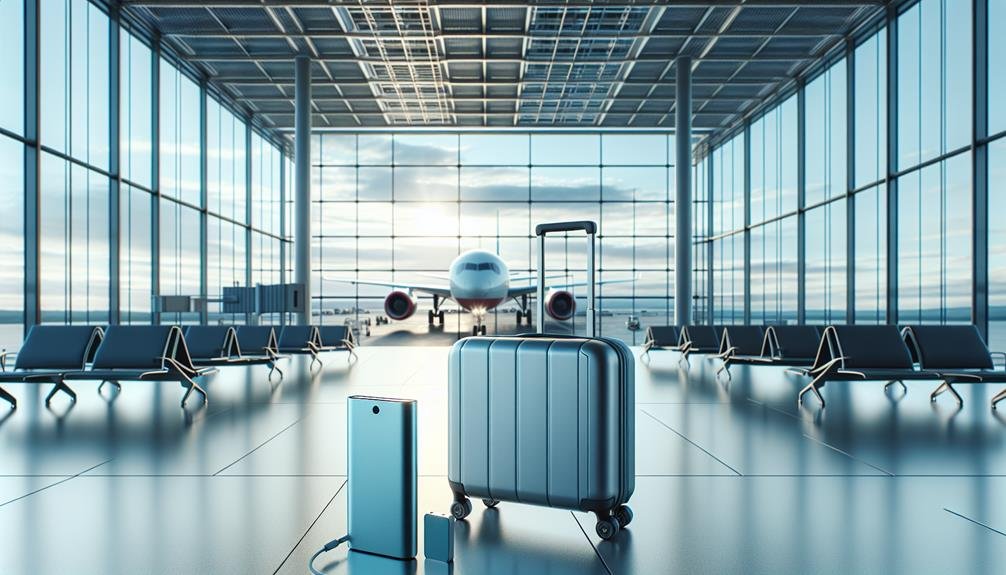Yes, you can carry power banks in your carry-on luggage, but they're not allowed in checked bags. Make certain your power bank doesn't exceed 100 watt-hours, and check if your airline allows you to carry up to two. Always confirm with the latest TSA guidelines and your airline's policies prior to traveling. Confirm your power bank's in good condition, without any damage signs, and has safety features like overcharging protection. For a safer and smoother travel experience, consider wrapping your power bank in a durable case and keeping cables separate. There's more to discover about optimizing your travel with power banks.
Airline Regulations
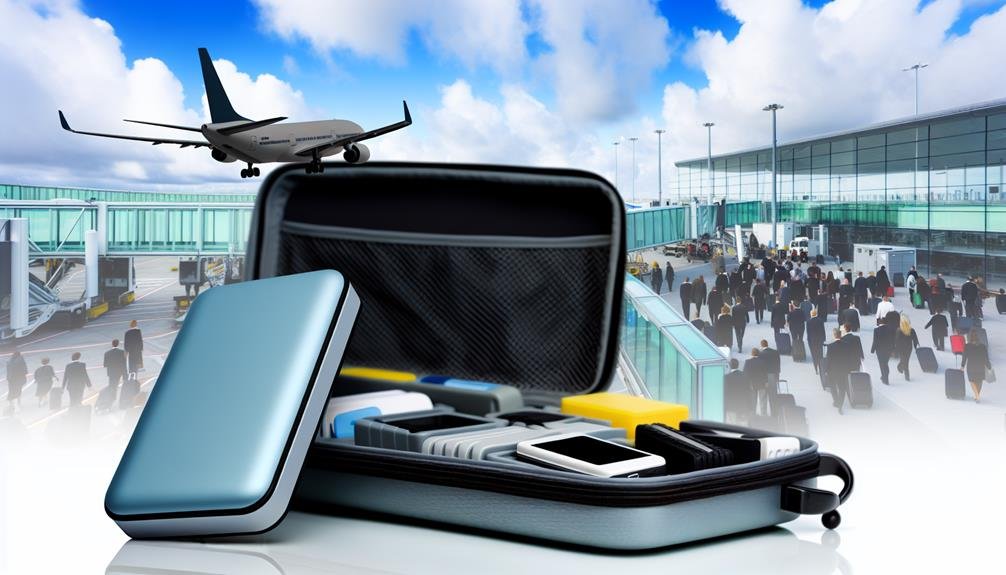
Airline regulations frequently require that power banks be carried in your carry-on luggage rather than checked baggage. This policy ensures that any potential issues with lithium-ion batteries can be quickly addressed by flight staff, enhancing overall safety. When selecting a power bank for travel, you should consider its charging options and device compatibility. Confirm the power bank can efficiently charge your specific devices, whether they are smartphones, tablets, or laptops.
Voltage requirements and charging speed are essential factors to keep in mind. Different devices have varying voltage needs, so verify that your power bank meets these requirements to avoid damaging your electronics. Additionally, a power bank with multiple voltage settings can be more versatile and safer for use with various devices.
Charging speed is another significant consideration. Some power banks offer fast-charging options, which can be particularly useful during travel when time is limited. However, be cautious not to surpass the recommended charging speed for your devices to maintain their longevity and safety.
TSA Guidelines
The TSA has specific guidelines that you must follow when carrying power banks in your carry-on luggage. Adhering to these rules guarantees both your safety and that of your fellow passengers. Power bank safety is a critical concern due to the potential risks associated with lithium-ion batteries. Therefore, the TSA enforces detailed airplane rules to mitigate these risks.
When packing your power bank, be mindful of TSA guidelines regarding power bank capacity restrictions. Power banks with a capacity of up to 100 watt-hours (Wh) can be brought in your carry-on without prior approval. For those between 100 Wh and 160 Wh, you're allowed to carry only two and must get airline approval. Power banks over 160 Wh are strictly prohibited in both carry-on and checked luggage.
Additionally, make sure that your power bank is securely packed to prevent any accidental activation. It's advisable to keep it in a protective case or separate compartment within your bag. Following these guidelines not only complies with TSA regulations but also enhances overall travel safety. Always check the latest TSA updates before your trip, as regulations can change. Safety should always be your top priority.
Power Bank Types
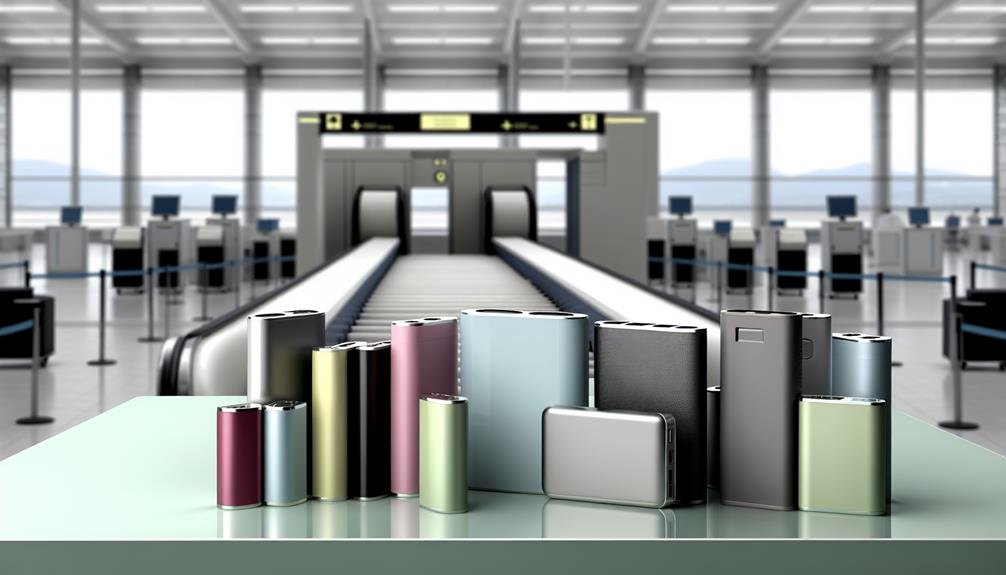
When choosing a power bank, you'll come across various types designed to meet different needs and preferences. Understanding these options can help you select the most appropriate and safe device for your travels.
Here are four main types of power banks:
- Standard Portable Chargers: These are the most common and versatile. They come with various charging options, including USB-A, USB-C, and even Quick Charge capabilities. Their battery life can vary widely, making it important to choose one that fits your specific requirements.
- Solar Power Banks: Ideal for outdoor and eco-conscious users, these chargers harness solar energy. While convenient, they typically offer slower charging times compared to traditional methods. It's crucial to have realistic expectations about their battery life and charging efficiency.
- Wireless Charging Power Banks: These provide the convenience of cable-free charging. They are compatible with devices that support Qi wireless charging. However, always make sure the wireless feature doesn't compromise the power bank's overall capacity and battery life.
- Ultra-Compact Power Banks: Designed for maximum portability, these are lightweight and easy to carry. They may offer fewer charging options and a shorter battery life, but their convenience is unmatched for quick, on-the-go power boosts.
Choose wisely to ensure safety and efficiency.
Capacity Limits
When bringing power banks in your carry-on, you must be aware of airline capacity regulations and battery size restrictions. Most airlines limit the capacity of power banks to 100 watt-hours, though some may allow up to 160 watt-hours with prior approval. Always check with your airline to confirm that your power bank complies with their specific guidelines.
Airline Capacity Regulations
Before packing your power bank, make certain it complies with airline capacity regulations to avoid any issues during your flight. Airlines have specific rules regarding power bank storage and usage, and understanding these can guarantee your journey remains smooth and safe. It's important to be conscious of the power bank size and capacity limits set by your airline to avoid confiscation or fines.
Here's a quick guide to help you navigate these requirements:
- Check Airline Policies: Each airline has distinct policies regarding power banks. Always review your airline's requirements before travel.
- Capacity Limits: Generally, power banks with a capacity of up to 100Wh are allowed in carry-on luggage. Those between 100Wh and 160Wh usually require airline approval.
- Carry-On Restrictions: Power banks are typically prohibited in checked luggage due to safety concerns. Instead, they should be placed in your carry-on bag.
- Quantity Limits: Most airlines permit up to two power banks per passenger, but this can vary. Verify with your airline to guarantee compliance.
Following these guidelines will help you stay within safety regulations and avoid complications during your trip. Always prioritize safety and confirm the latest rules directly with your airline.
Battery Size Restrictions
Understanding battery size restrictions is necessary to make certain your power bank complies with airline regulations and avoids any travel disruptions. Airlines typically allow power banks with capacities up to 100 watt-hours (Wh) in carry-on luggage without prior approval. For power banks between 100Wh and 160Wh, you'll need airline approval before boarding. Exceeding these limits can result in confiscation or denied boarding, so it's essential to verify your power bank's specifications.
Most power banks list their capacity in milliampere-hours (mAh). To determine if your device is within safe limits, convert mAh to Wh using the formula: (mAh/1000) x Voltage = Wh. Standard power banks generally operate at 3.7V, making the conversion straightforward. For instance, a 20,000mAh power bank translates to 74Wh, well within acceptable limits.
Checking power bank compatibility with airline regulations also involves considering the device's charging options. Multi-port power banks or those with fast charging capabilities should still comply with capacity restrictions. Opt for models that clearly indicate their capacity to avoid any confusion. Always check with your airline for specific guidelines to guarantee a safe and hassle-free journey.
Safety Concerns
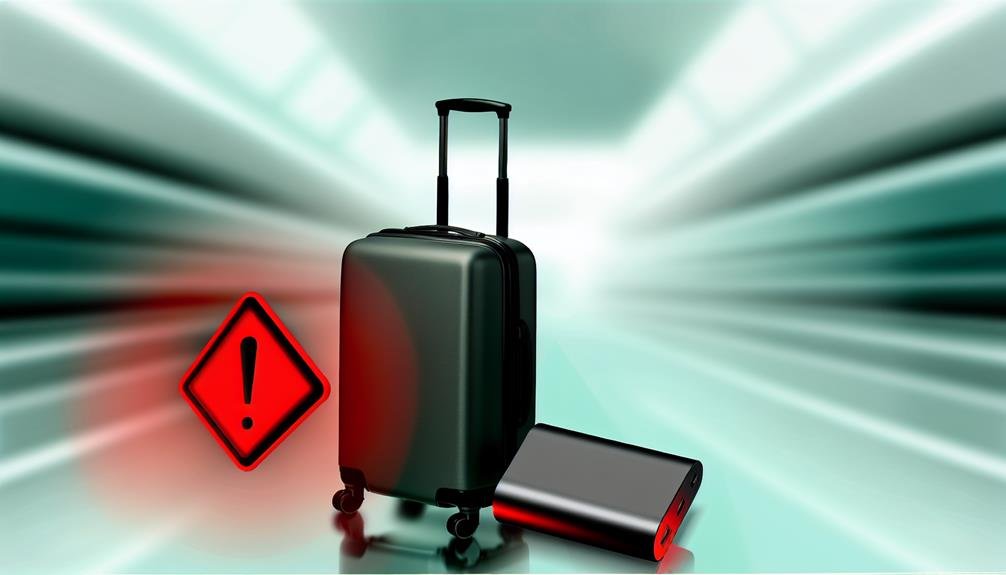
Given the potential risks associated with lithium-ion batteries, it's important to be mindful of the safety concerns when carrying power banks in your carry-on luggage. By understanding these risks, you can guarantee a safe and hassle-free travel experience.
First, be cautious of voltage restrictions when flying, especially during international travel. Power banks with high voltage can be problematic and may not meet airline regulations. Always check the voltage and capacity limits set by the airline and adhere to them strictly.
Second, overcharging risks are a significant concern with lithium batteries. Overcharging can lead to overheating and, in extreme cases, cause fires. Make sure your power bank has built-in protection against overcharging and overheating.
Here are some essential safety tips to keep in mind:
- Check Voltage Limits: Guarantee your power bank meets airline voltage restrictions.
- Avoid Overcharging: Use power banks that have built-in safety features to prevent overcharging.
- Inspect for Damage: Regularly check your power bank for any signs of damage or swelling.
- Keep it Accessible: Always store your power bank in your carry-on, never in checked luggage.
Packaging Tips
When packing your power bank in a carry-on, it's important to use proper wrapping techniques to avoid damage. Make sure the device is securely padded to prevent any impact during travel. Additionally, take steps to protect the battery from potential hazards, like short circuits or punctures.
Proper Wrapping Techniques
To safeguard your power bank remains safe and undamaged during travel, use a protective case that fits snugly around the device. Proper wrapping methods are crucial to secure that your portable charger doesn't suffer any harm. Here are some steps you should follow:
- Choose a Durable Case: Opt for a protective case made of tough materials like hard plastic or silicone. This will shield your power bank from impacts and scratches.
- Wrap in Bubble Wrap: Before placing the power bank in its case, wrap it in a layer of bubble wrap. This provides an additional cushion against shocks and vibrations.
- Avoid Overpacking: Guarantee the protective case fits the power bank snugly without extra room for the device to move around. Overpacking can lead to internal damage.
- Keep Cables Separate: Store charging cables separately to avoid tangling and potential damage to the connectors. Utilize cable organizers or small pouches for this purpose.
Preventing Battery Damage
Securing your power bank's battery remains undamaged during travel requires careful packaging techniques. First, use a protective case specifically tailored for power banks. This will shield your device from physical impacts and potential short circuits. When selecting a case, make sure it's made of durable, fire-resistant materials.
To maintain peak battery health, follow these charging tips: avoid overcharging your power bank. Disconnect it as soon as it reaches 100% capacity. Overcharging can lead to overheating and reduce the battery's lifespan. For storage solutions, keep your power bank in a cool, dry place when not in use. Extreme temperatures can negatively affect battery performance and longevity.
When packing, ensure your power bank is compatible with your other devices. Mixing incompatible devices can cause voltage mismatches, leading to potential damage. Use only the cables and adapters recommended by the manufacturer to ensure secure charging.
Lastly, inspect your power bank regularly for any signs of damage or wear. If you notice bulging, leaks, or unusual odors, discontinue use immediately. Prioritizing battery maintenance and following these guidelines will help prevent damage, keeping your power bank reliable and safe during your travels.
Alternatives
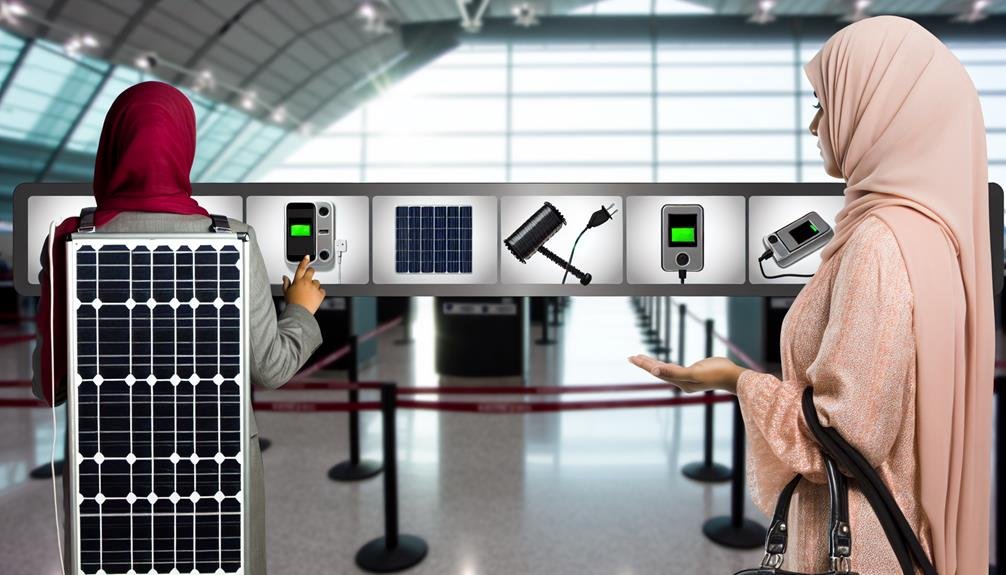
Exploring alternatives to carrying power banks in your carry-on can help streamline your travel experience and guarantee compliance with airline regulations. By exploring other options, you can make sure that your electronic devices stay charged without compromising safety. Here are some reliable alternatives to ponder:
- Packing Tips for Portable Chargers: Opt for smaller, less powerful portable chargers that meet airline regulations more comfortably. These can easily fit within your carry-on and provide enough power for your journey without posing a risk.
- Secure Storage of Electronic Devices: Utilize in-flight power outlets. Many modern aircraft offer USB ports or power outlets at every seat, allowing you to charge your devices safely throughout the flight.
- Battery-Integrated Devices: Ponder using devices with built-in battery packs. Laptops, tablets, and smartphones with extended battery life can minimize the need for separate power banks.
- Airport Charging Stations: Many airports are equipped with charging stations. Plan your itinerary to include time at these stations to make sure your devices are fully charged before boarding.
Travel Tips
While exploring alternatives to power banks can enhance your travel experience, it's also valuable to arm yourself with practical travel tips that secure your journey is smooth and hassle-free. First, always research the availability of charging stations at airports, train stations, and other transit hubs. Knowing where to recharge your devices can save you from inconvenient delays.
Next, consider carrying portable chargers. They're compact, reliable, and can keep your devices powered up when you're on the move. Make sure that your portable charger complies with airline regulations, especially concerning capacity and how it's packed in your carry-on.
If you're traveling internationally, prepare by bringing voltage converters and outlet adapters. Different countries use different types of electrical outlets and voltage standards. A voltage converter will protect your devices from potential damage due to voltage differences, while an outlet adapter ensures compatibility with local sockets.
Lastly, organize your electronic devices and accessories in a dedicated, easily accessible section of your carry-on. This not only streamlines security checks but also helps you quickly find what you need. Following these tips can notably enhance the safety and efficiency of your travel experience.
Frequently Asked Questions
Can I Charge My Power Bank During the Flight?
You can't typically use in-flight charging for your power bank. Power bank regulations usually restrict their use during flights due to safety concerns. Always check with your airline for specific guidelines to guarantee compliance.
Do Power Banks Affect My Device's Battery Life?
Just like a balanced diet sustains health, your charging habits and power bank compatibility can impact battery capacity and device lifespan. Use certified power banks and avoid overcharging to guarantee your device remains safe and efficient.
How Do I Know if My Power Bank Is Fully Charged?
To know if your power bank's fully charged, check the battery indicator. Confirm you adhere to the recommended charging time and verify the voltage output. Prioritize charging safety to prevent overcharging and potential hazards.
Can Power Banks Be Used in Extreme Temperatures?
When it comes to power bank safety, don't play with fire. Power banks shouldn't be used in extreme temperatures. Temperature regulation is essential to avoid damage or potential hazards. Always follow manufacturer guidelines for safe usage.
Are There Any Power Banks Specifically Designed for International Travel?
Yes, you'll find power banks with a travel-friendly design and global compatibility. Look for models with multiple plug adapters and universal voltage support, ensuring a safe and efficient charging experience wherever your travels take you.

